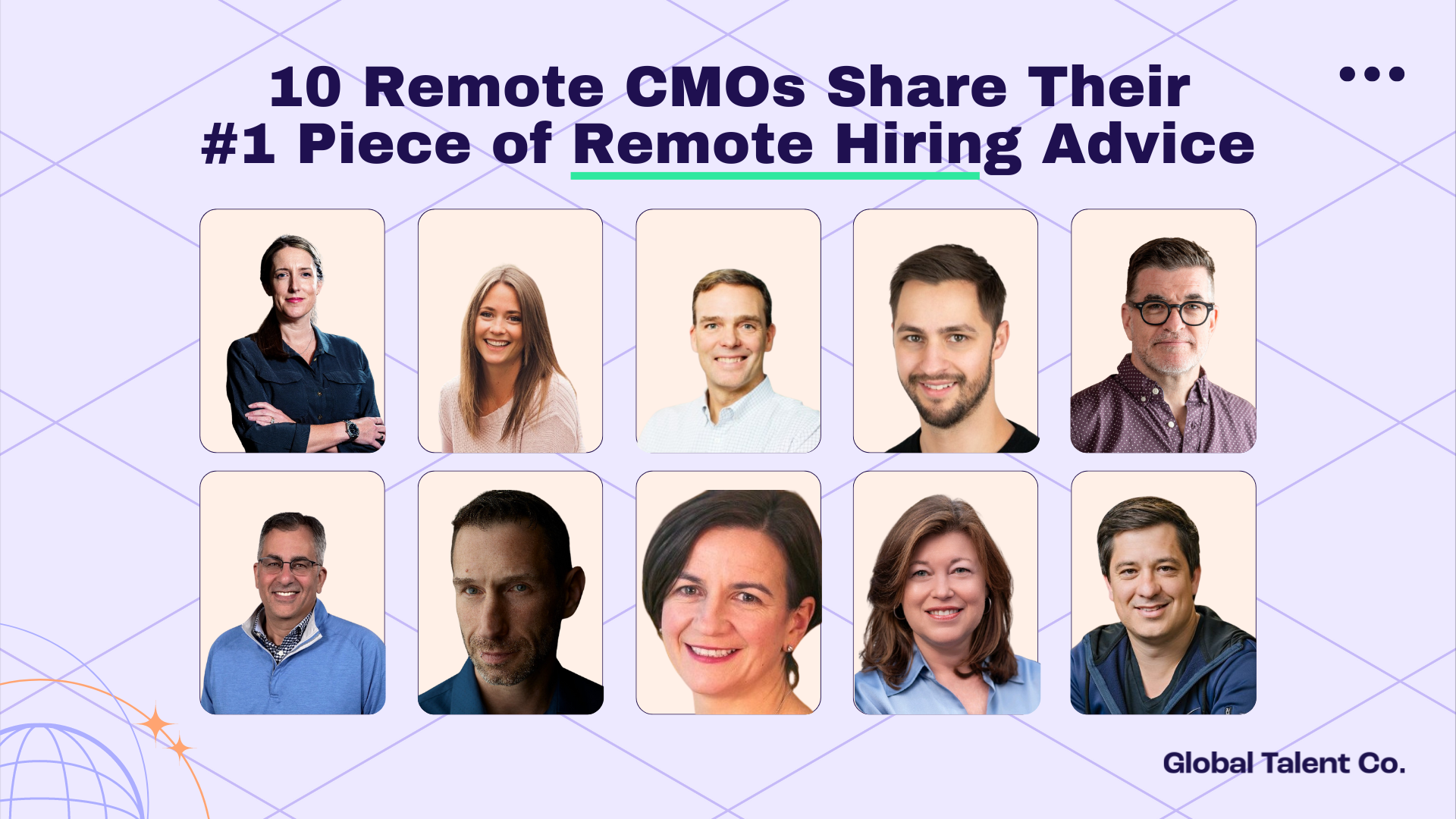Let’s face it: running a remote marketing team is a whole different ballgame. And while there’s tons of advice out there on marketing strategies, finding solid tips on managing a high-preforming remote marketing team? Not so much.
That’s why we created The Remote CMO podcast. We’re picking the brains of leading remote CMOs from fast-growing technology companies.
We asked 10 of these marketing leaders one simple question: “What’s your #1 tip for hiring and managing success in a remote environment?” Here’s the gold they dropped:
#1 Build a Rhythm of Quick Check-Ins
“I think it’s important to build a rhythm of quick check ins and skip levels. So not just talking to your direct reports, but jumping on with quick huddles on slack or dropping quick voice notes with people who are not directly on your team. And that personality you can bring, I think, is just really important rather than it just being perhaps a written message every time. So think about how you can drop a video to everybody or drop a voice note to someone specific, because then you can communicate a much more empathy and personality in those moments than you can if everything is just very specific and written. So yeah, building that rhythm of quick check ins and skip levels and using different methods and media to connect with different people, I think is really important. – Andrew Davies, CMO of Paddle
#2: Don’t Compromise on Core Values
“I might sound like a broken record, but I would say don’t ever compromise on your core values. Whatever you define, those are for your company once you start compromising on your core values. And it’s just a really slippery, slippery slope. It’s just a great way, like, a compass to use to make all of the decisions that you need to make as a remote team. And, you know, I’m sure Cola co located teams need these as well. But it becomes especially critical for remote teams because, like, you know, if people aren’t aligned with your core values, then, like, you know, how are you going to hold them accountable to, like, working remotely? How are you going to trust them? How are you going to, like, have these measurement tools to say, like, this is okay, this isn’t. So that is definitely my number one piece of advice.” – Brenna Loury, CMO, Doist
#3: Build Relationships Quickly
“Oh, it depends. It’s really a tricky thing. You give me a really hard question there, Brett, to answer, to decide on what to go in on in terms of, you know, perhaps, you know, do we jump in with marketing or people? But if you’re first time CMO and you’re working with a remote, working within a remote environment, I think it’s really essential to build your relationship quickly inside the company. Get to know everybody fast, spend time with people, understand their function. It’s much easier when you’re in an office environment because you can pop along and go to the different floors or the different departments, grab a cup of coffee. It’s much more natural. Whereas I think within the remote setting, I think it can be, yeah, it feels perhaps a little bit more forced and it shouldn’t be. But that would be my number one thing, I think that’s really integral to you carving off a successful career and people working with you in the right way is get to know everybody, spend time, listen, learn about the company, about how it operates, because that’s going to be intrinsic to how you then build your team.” – Carly Marsh, CMO of Sketch
#4: Assess the Culture and Challenges
“I think doesn’t matter if it’s remote or physical, I would always check what culture am I working at? What problem am I solving? How complex is it? How much exchange do I need? And then if it’s a purely remote versus non remote question, and I would base that criteria or that insights versus can I deliver there, am I consistently happy? And can I drive a team that is also working remote there? I think it’s very challenging. Consistently deliver remotely, but it’s doable. But I would very much choose which product, which service and most important, which culture am I going into? How open are they? What’s their setup? What’s the experience and what successes have been there before?” – Tobias Haudė, Marketing Director of Hear.com
#5: Be More Deliberate in Your Approach
“Take a breath. I think people who are coming from a non remote world assume that everybody feels good, everybody knows what they’re doing, they’re talking to each other, they’re getting what they need, et cetera, et cetera. And you just have to kind of steer them in the right direction, give them the proper coordinates and then be there when they need you. I think that’s a little bit naive in this newer context. I think you have to be a little bit more deliberate in your asking how people are doing. I think you have to be a little bit more forthright in how you might be doing. I think you have to be a little bit more prescriptive in terms of what needs to happen for second and third, or at least your vision of that. I think you need to ask a lot more questions that perhaps would have seemed more intuitive in a past life. I would say it actually is going to take you a little bit more time in a remote context than when everybody was in there.” – Patrick Reynolds, CMO of BlueConic
#6: Communicate Frequently and Set Clear Expectations
“I mean, I’ve said it already, but I think the biggest thing is communicate frequently and often in short periods, like over communicate, especially upfront. Spend the time upfront setting expectations and getting people to see how you want to operate and what you expect of them. Where you have these daily huddles, like anybody that has a full remote team that’s not meeting with their team for 15 minutes every day, I would say you really are not setting your team up for success. You may not need that 15 minutes and you’ll be like, hey, all good. Same priorities as yesterday. No need. Great. Just checking in frequently, often. And be accessible for those people because you can start coaching them on, hey, you don’t need to bring me in on everything, but here’s some ways that you can handle this.” Gino Palozzi, CMO of DailyPay
#7: Allow Your Team to Fail
“I think, both controversial and true. And again, I’ll use myself as a use case here at your organization, who knows the financial pipeline plan better than anyone else. So at heap, at envoy, at junk cloud, at eventbrite, I am deeply involved with the planning. Every assumption, what’s the average deal size? What’s the closure, what’s the assumption on cost per that MQL is the next quarter plan and 20 40% more than you got in quarter. That’s not okay. Thinking about it at the segment level. For example, right now, you know, maybe Germany is doubling plan, but the US is off of plan. Well, no, like, I don’t want wild swings. I want predictability. So like I get in there, I work with finance and have a ton of influence on those numbers. You will hit your numbers more regularly. You will demonstrate to your CEO, CRO and CFO that you really understand the business and your team will feel that transformation.” – Micah Hershman, CMO of JumpCloud
#8 Hire For Your Weaknesses
“I am a big believer in hiring for your weaknesses. So do a little like self perfection and say, what am I not good at? Right. And then go find someone who’s amazing at that. Because I think what you’ll bring then is just a better team. Right. So if you’re not analytical and you know you’re not, so you’re creative and you love storytelling, but you just do not like the data or the then hire a rev ops. Like make that your first hire and always be building for the gaps is what I try to do” — Marie Moynihan, Chief Marketing Officer
#9: Understand and Adapt to Their Communication Style
“I think understanding how they’re communicating, what those kind of key touch points on, particularly when you’re a mode organization, I think will really help them get started quicker because you want to kind of be on their speed a little bit, and then you can make changes or tweaks, but join them where they are if you can.” – Michelle Harmon-Madsen, CMO of SponsorUnited
#10: Connect and Set Up for Success
“Number one, connect with them, especially as being a new CMO in a new situation and where not everybody is there at once. I take the time in the first 90 days and go out and connect with them and let them know who you are as a person and as a human. And then I think secondarily it would be help set them up for success and understand why they are in this position. What is their, why do they have belief in the company and the product? Can you help them with their belief in their future career? And can you be a cheerleader for them, whether at this company or others, long term?” – Brett Billick, CMO of Self Financial
There you have it, folks. Ten actionable tips from leading remote CMOs who’ve been there, done that, and got the virtual t-shirt.
The big takeaway? Being deliberate is key. You can’t rely on water cooler chats or impromptu brainstorms anymore. It’s all about creating those moments intentionally in the digital space.
As we keep riding this remote work wave, these strategies aren’t just nice-to-haves – they’re must-haves for any CMO looking to build a team that doesn’t just survive, but thrives in the remote world.

